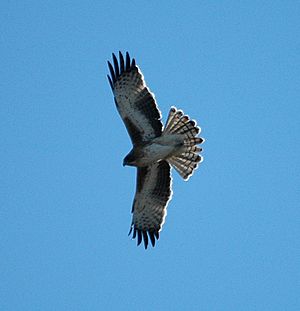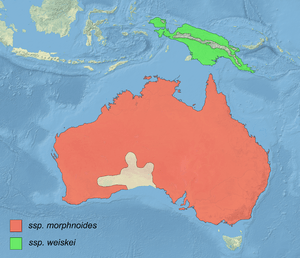Little eagle facts for kids
Quick facts for kids Little eagle |
|
|---|---|
 |
|
| In flight | |
| Conservation status | |
| Scientific classification | |
| Genus: |
Hieraaetus
|
| Species: |
morphnoides
|
 |
|
| Little eagle range in red (pygmy eagle range in green) | |
| Synonyms | |
|
|
The little eagle (Hieraaetus morphnoides) is a small but powerful eagle that lives in Australia. It measures about 45–55 cm (17–21.5 inches) long and weighs around 815 grams (1.8 lb). This makes it similar in size to a peregrine falcon.
Little eagles prefer open areas like woodlands, grasslands, and dry regions. They usually stay away from thick forests. This eagle is related to the booted eagle found in Europe and Asia, and also to the huge, now extinct Haast's eagle from New Zealand.
Contents
Eagle Family Tree: Taxonomy
The little eagle was first described by John Gould in 1841. For a long time, another eagle called the pygmy eagle was thought to be a type of little eagle. However, a study in 2009 showed that the pygmy eagle is different enough to be its own species.
What the Little Eagle Looks Like
The little eagle is a medium-sized bird of prey, about 45 to 55 cm long. It has a sturdy body and a wide head. Its legs are covered in feathers, and its tail is square-shaped with stripes. When it flies, its wings can spread out to about 120 cm. Male eagles have longer wings compared to their bodies, but they weigh almost half as much as females.
This eagle is a strong flyer. It beats its wings powerfully, glides with flat wings, and soars high in the sky.
Little eagles can be found in two main color forms: light and dark. Their colors often change as they get older.
- The most common form is light-colored. These eagles have dark brown backs and wings. Their heads and necks have black streaks, and their undersides are sandy to pale.
- The dark form is similar, but its head and underside are usually a darker brown or a rich reddish-brown.
Males and females look alike, but females are usually larger and a bit darker. Young eagles look similar to adults but are often more reddish and have less clear patterns.
Where Little Eagles Live and Their Numbers
Little eagles live in most parts of Australia, except for very dense forests in the Great Dividing Range. Sadly, like many Australian animals, their numbers are decreasing. This is mainly because they are losing their homes (habitat) and have to compete with other animals.
One big reason for their decline is the drop in rabbit numbers. Rabbits became a major food source for the eagles after many native mammals, like bandicoots and small wallabys, disappeared or became rare. When a disease called calicivirus was released, it greatly reduced the rabbit population. This left the eagles with less food.
Over the past 20 to 30 years, the number of little eagles seen in places like New South Wales (NSW) and Victoria has gone down significantly. For example, in NSW, their numbers have dropped by about 39% in the last 20 years.
The little eagle used to be common in the Australian Capital Territory (ACT). However, its population there has also dropped by more than 70% in the last 20 years. In the late 1980s, there were about 13 breeding pairs in the ACT. By 2005, only one unsuccessful nest was found. Recent surveys have found a few breeding pairs, but their numbers are still very low.
Little eagles prefer to live in woodlands or open forests. They are often found on hillsides where there's a mix of wooded and open areas, like along rivers or at the edges of forests. They use trees as lookout spots to hunt in open woodlands.
Protecting the Little Eagle: Conservation Status
The little eagle has been listed as 'Vulnerable' in the Australian Capital Territory (ACT) and New South Wales (NSW). This means they are at risk of becoming endangered if their situation doesn't improve.
However, on the IUCN Red List, which is a global list of threatened species, the little eagle is listed as 'Least Concern'. This is because it has a very large range across Australia (up to 20,000 square kilometers). Also, its population is decreasing at a slower rate than what is needed to be classified as 'Vulnerable' globally. Even so, local governments in Australia recognize the serious decline in certain areas.
The main reasons for its 'Vulnerable' listing in NSW include the loss of good quality habitat and a reduction in the variety of its genes (genetic diversity).
Little Eagle Life and Habits: Ecology and Behaviour
Reproduction and Life Cycle
Little eagles build their nests in open woodlands, often on hillsides or along rivers lined with trees. They usually place their nests in strong, living trees. They build a stick nest and line it with leaves. Sometimes, they use nests built by other birds, like crows.
Little eagles only reproduce once a year. Each pair usually lays one or two eggs, typically in late August or early September. The eggs hatch after about 37 days. The young eagles stay in the nest for about eight weeks before they can fly (fledge).
Eagles become old enough to breed when they are two to three years old. This means that a large part of the eagle population is made up of young eagles that are not yet ready to have their own families.
Little eagles protect their nesting areas from other birds. They show off their territory by soaring in the sky, flying in wavy patterns, perching in clear view, or calling out. Some eagles stay in one place all year, while others might move to different altitudes depending on the season. They tend to fly away if humans get too close.
What Little Eagles Eat: Prey
Little eagles hunt live prey, but they will sometimes eat dead animals (carrion). They look for food by soaring high in the sky (up to 500 meters) or by watching from a high, open perch. They are quick and agile hunters, swooping down to catch prey on the ground, or even from trees and bushes.
Their diet can vary a lot, depending on what food is available and the right size. Originally, little eagles ate small birds, mammals, and reptiles, sometimes adding large insects to their diet. However, when rabbits and foxes were brought to Australia, the eagles' diet changed.
Rabbits became very common, and the little eagle started to rely on them as a main food source. But then, the calicivirus disease caused a huge drop in rabbit numbers (between 65% and 85% in some areas). This meant less food for the eagles.
What they eat also depends on where they live:
- In Northern Australia, they eat a lot of birds.
- In dry areas, they mostly eat lizards.
- In Southern Australia, they eat many young rabbits.
Near Canberra, their diet is mostly rabbits, and also birds like rosellas and starlings.
Little eagles sometimes compete for food with the larger wedge-tailed eagle (Aquila audax). Wedge-tailed eagles tend to hunt bigger prey and eat more dead animals. However, rabbits are a common food for both eagles near Canberra. This means they might compete for the same food. Wedge-tailed eagles are also more numerous, and they might keep little eagles away from dead animals like macropods (kangaroos and wallabies), meaning little eagles might eat more carrion if they weren't chased away.
Threats to the Little Eagle
The biggest dangers to the little eagle are the loss and damage of their hunting and breeding grounds. This forces them to compete with the larger and more dominant wedge-tailed eagle.
While the wedge-tailed eagle doesn't usually hunt little eagles, they share the same homes and food. Because wedge-tailed eagles are bigger and stronger, they might push little eagles out of good hunting and nesting areas. They could even kill and eat them if they are competing for resources.
Images for kids
-
A little eagle in aerial conflict with a black-shouldered kite.
-
Foot bones of the little eagle (bottom) and those of the Haast's eagle.
See also
 In Spanish: Aguililla australiana para niños
In Spanish: Aguililla australiana para niños





